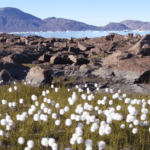Ever wonder where your manuscript goes after you hit “Submit”? At Botany it arrives in the inbox of Editor-in-Chief Dr. Christian Lacroix. Next, it is assigned to one of the journal’s 35 Associate Editors who secure reviewers and guide your manuscript through the peer-review system. This “Behind the Scenes” series will share the stories and research of this fantastic editorial team. Today we get to know Drs. Gunawardena, Thorn, Shamoun, and Sanita’ di Toppi.
Dr. Arunika Gunawardena
Professor, Biology Department, Dalhousie University

Dr. Arunika Gunawardena
Years with Botany: 5.5
Research program: Understanding the role of programmed cell death (PCD) in plant development.
Why you serve on the Editorial Board: It’s a wonderful opportunity to learn and review botanical manuscripts by other researchers.
Most memorable research moment: The moment Dr. Nancy Dengler introduced me to the fascinating lace plant 17 years ago…it is still exciting to me today!
Favourite botanical species: Madagascar laceleaf (Aponogeton madagascariensis)
When I’m not studying PCD, I can be found in the kitchen cooking Sri Lankan food or enjoying nature with my husband and daughter.
Readers can learn more about Dr. Gunawardena’s work and the lace plant here.
Dr. Greg Thorn
Associate Professor, Department of Biology, Western University
Curator, Western University Herbarium

Dr. Greg Thorn
Years with Botany: 15—I think!
Research program: Research in my lab is focused on the ecology and systematics of mushroom fungi, particularly how disturbance affects their diversity and ecological function.
Why you serve on the Editorial Board: Larry Peterson asked me to serve as Associate Editor soon after I joined the faculty at Western [University] in 2000, and I was delighted to accept because of the great history that Botany has in the subject area of mycology.
Most memorable research moment: That’s tough—the most memorable are places I have been and people I have interacted with in the process of research, but among my favourite moments are solving old puzzles (nomenclature, phylogeny, and ecology) using new information.
Favourite botanical species: Again, that’s tough, but my tongue-in-cheek response would be Black Spruce (Picea mariana)—a very Canadian species, growing coast to coast, rather unassuming but very hardy, and—like Canada—host to a huge fungal diversity!
When I’m not running phylogenetic trees or analyzing Illumina community genomic sequence data, I can be found reading old taxonomic papers, now available online through resources such as CyberLiber and the Biodiversity Heritage Library.
Readers can learn more about Dr. Thorn’s work here and recent discoveries in chanterelles here.
Dr. Simon Francis Shamoun
Research Scientist, Natural Resources Canada, Canadian Forest Service, Pacific Forestry Centre

Dr. Simon Francis Shamoun
Years with Botany: 14
Research program: My research focuses on the biology, molecular detection, identification, and development of mitigation tools for the Sudden Oak Death (Phytophthora ramorum), decay fungi associated with wood products (e.g., Heterobasidion spp.), and emerging invasive alien forest pathogens. The overall objective of my research work is to protect both Canadian forest ecosystems and market access for Canadian wood products.
Why you serve on the Editorial Board: As an academic editor, I enjoy contributing to [the] scientific community. This [position has] allowed me both to gain invaluable experience in the processes of editing [and] reviewing and [to connect] with colleagues in my area of expertise and related fields.
Most memorable research moment: The most memorable moment in my scientific career was the development, registration, and commercialization of Canada’s first biological control product “Chontrol®” based on using the wood decay fungus Chodnrostereum purpureum as a biocontrol agent for management of weedy woody vegetation in conifer plantations and utility rights-of-way.
Favourite botanical species: Douglas-fir tree (Pseudotsuga menziesii)
When I’m not studying forest fungi, I can be found gardening, listening to classical music, and watching sports tv channels with [a] great interest in international soccer games.
Readers can learn more about Dr. Shamoun’s work and scientific publications here.
Dr. Luigi Sanita’ di Toppi
Professor, Dipartimento di Biologia, Università di Pisa

Dr. Luigi Sanita’ di Toppi
Years with Botany: 9
Research program: Cytological, functional, and molecular aspects of plant response to heavy metals, with particular focus on phytochelatin biosynthesis and evolutionary aspects of the phytochelatin synthase enzyme functioning.
Why you serve on the Editorial Board: I like [giving] a hand to the progress of the journal and…in general, [providing] my contribution for evaluation of the scientific work submitted to Botany.
Most memorable research moment: When I got a prize for my work [at] an international botanical meeting.
Favourite botanical species: Smooth hornwort (Phaeoceros laevis)
When I’m not studying botany and plant physiology, I can be found running in the park.
Readers can learn more about Dr. Sanita’ di Toppi’s scientific publications here.




